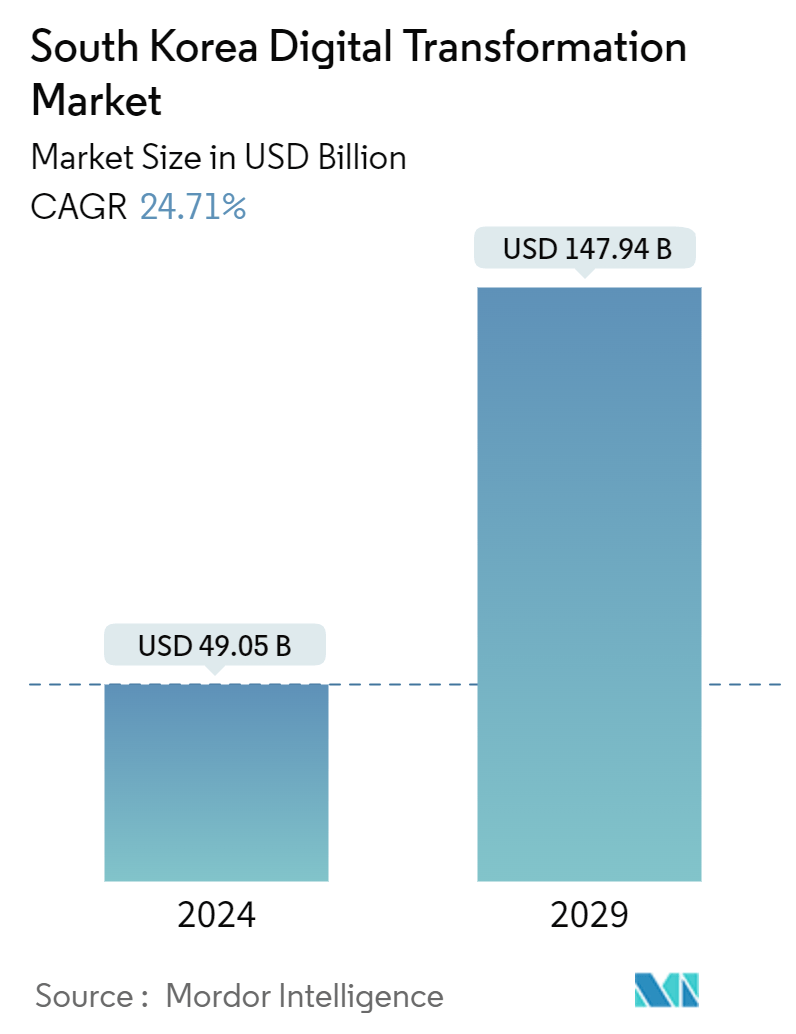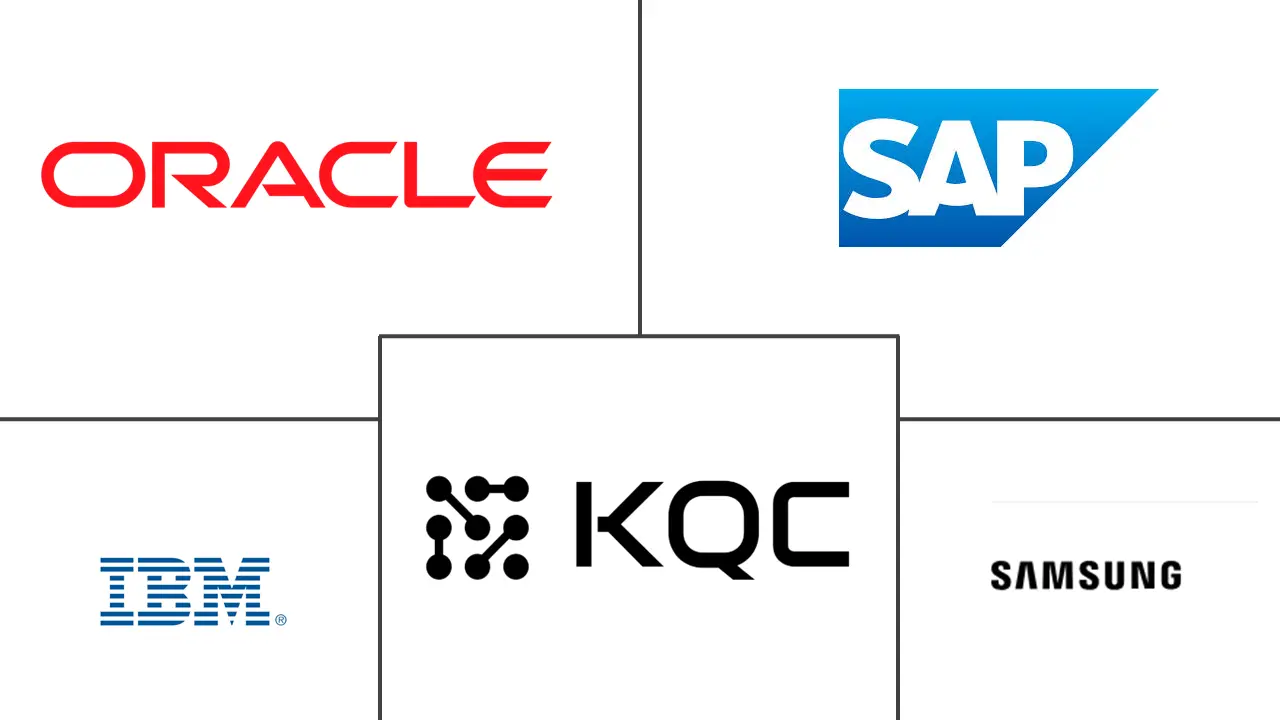Market Size of South Korea Digital Transformation Industry

| Study Period | 2019 - 2029 |
| Base Year For Estimation | 2023 |
| Forecast Data Period | 2024 - 2029 |
| Market Size (2024) | USD 49.05 Billion |
| Market Size (2029) | USD 147.94 Billion |
| CAGR (2024 - 2029) | 24.71 % |
| Market Concentration | Low |
Major Players
*Disclaimer: Major Players sorted in no particular order |
South Korea Digital Transformation Market Analysis
The South Korea Digital Transformation Market size is estimated at USD 49.05 billion in 2024, and is expected to reach USD 147.94 billion by 2029, growing at a CAGR of 24.71% during the forecast period (2024-2029).
- AI is being integrated across various sectors, including healthcare, finance, manufacturing, and retail. There are significant opportunities for AI-driven innovations in predictive analytics, personalized customer experiences, and automated processes. For instance, in April 2024, South Korean President Yoon Suk Yeol announced that South Korea planned to invest approximately USD 6.94 billion (9.4 trillion won) in artificial intelligence by 2027. This move is a strategic endeavor to solidify the nation's dominance in semiconductor chips.
- The government is also investing heavily in smart city projects that integrate IoT, big data, and AI to improve urban living. For instance, BUSAN (South Korea's second-largest city) aims to create Eco-Delta City (EDC), positioned as the national flagship for smart city initiatives. EDC is aimed at showcasing the future of urban living. The primary goal is to tackle urban challenges with a focus on investing in sustainable lifestyles for its residents. The city's vision is to elevate the quality of life, especially for its aging population, by bolstering healthcare services and overall well-being. Furthermore, EDC prioritizes real-time disaster management, from floods to fires, as a cornerstone of its citizen safety strategy.
- The adoption of cloud services is accelerating as businesses seek scalable and flexible IT solutions. There’s a growing trend toward hybrid and multi-cloud environments supported by major providers like AWS, Google Cloud, and local players. Government initiatives are also focusing on accelerating digital transformation by investing in data infrastructure, including cloud computing and AI initiatives.
- Stringent data protection and privacy laws prevent the adoption of new technologies, particularly those involving data analytics and cloud computing. Moreover, implementing digital transformation requires significant infrastructure, software, and training costs, which restricts smaller organizations' entry into the market.
- The pandemic accelerated digital transformation growth across various sectors, pushing companies to adopt digital tools and processes to maintain operations. The surge of e-commerce activities shifted consumers toward online shopping, necessitating digital infrastructure, payment systems, and cybersecurity improvements.
South Korea Digital Transformation Industry Segmentation
Digital transformation means incorporating digital technologies such as analytics, artificial intelligence, and machine learning, extended reality (XR), Iot, industrial robotics, blockchain, additive manufacturing/3D printing, cybersecurity, cloud and edge computing, and others (digital Twin, mobility, and connectivity) in various end-user industries across Japan.
South Korea’s digital transformation market is segmented by type [analytics, artificial intelligence, and machine learning, extended reality (XR), Iot, industrial robotics, blockchain, additive manufacturing/3D printing, cybersecurity, cloud and edge computing, and other types (digital twin, mobility, and connectivity)] and end-user industry [manufacturing, oil, gas, and utilities, retail & e-commerce, transportation and logistics, healthcare, BFSI, telecom and IT, government and public sector, and other end-user industries (education, media & entertainment, environment etc)]. The market sizes and forecasts are provided in terms of value (USD) for the segments.
| By Type | |||||||
| |||||||
| |||||||
| |||||||
| |||||||
| |||||||
| |||||||
| |||||||
| |||||||
|
| By End-user Industry | |
| Manufacturing | |
| Oil, Gas, and Utilities | |
| Retail & e-commerce | |
| Transportation and Logistics | |
| Healthcare | |
| BFSI | |
| Telecom and IT | |
| Government and Public Sector | |
| Other End-user Industries (Education, Media & Entertainment, Environment etc) |
South Korea Digital Transformation Market Size Summary
The South Korea digital transformation market is poised for significant growth, driven by substantial investments in artificial intelligence, cloud computing, and smart city initiatives. The government's strategic focus on AI and machine learning technologies aims to position South Korea as a global leader in these fields by 2030, with initiatives like the "AI National Strategy" and collaborations with international partners such as the United States, Japan, and the European Union. The integration of AI across various sectors, including healthcare, finance, and manufacturing, is expected to enhance predictive analytics, personalized customer experiences, and automated processes. Additionally, the rollout of 5G technology provides the necessary infrastructure for advanced applications, facilitating the deployment of AI and ML solutions in smart cities, industrial automation, and autonomous vehicles.
The market is characterized by a fragmented landscape with numerous players, including IBM Corporation, Oracle Corporation, and Samsung Electronics, engaging in mergers, acquisitions, and product innovations to maintain a competitive edge. The adoption of hybrid and multi-cloud environments is on the rise, driven by the need for scalable and flexible IT solutions, with major providers like AWS and Google Cloud playing a significant role. Despite challenges such as stringent data protection laws and high implementation costs, the pandemic has accelerated the adoption of digital tools and processes, particularly in e-commerce, necessitating improvements in digital infrastructure, payment systems, and cybersecurity. The market's growth is further supported by strategic partnerships and collaborations, such as those between SK Telecom and Perplexity, and HD Hyundai and Naver, which aim to leverage advanced technologies to enhance operational efficiency and domain expertise.
South Korea Digital Transformation Market Size - Table of Contents
-
1. MARKET DYNAMICS
-
1.1 Market Drivers
-
1.1.1 Increase in the Adoption of Big Data Analytics and Other Technologies in the Country
-
1.1.2 The Rapid Proliferation of Mobile Devices and Apps
-
-
1.2 Market Restraints
-
1.2.1 Concerns About the Privacy and Security of Information
-
-
-
2. MARKET SEGMENTATION
-
2.1 By Type
-
2.1.1 Analytics, Artificial Intelligence, and Machine Learning
-
2.1.1.1 Current Market Scenario and Market Projections for the Forecast Period
-
2.1.1.2 Key Growth Influencers (Drivers, Challenges, and Opportunities)
-
2.1.1.3 Use Case Analysis
-
2.1.1.4 Market Outlook
-
-
2.1.2 Extended Reality (XR)
-
2.1.2.1 Current Market Scenario and Market Projections for the Forecast Period
-
2.1.2.2 Key Growth Influencers (Drivers, Challenges, and Opportunities)
-
2.1.2.3 Use Case Analysis
-
2.1.2.4 Market Outlook
-
-
2.1.3 IoT
-
2.1.3.1 Current Market Scenario and Market Projections for the Forecast Period
-
2.1.3.2 Key Growth Influencers (Drivers, Challenges, and Opportunities)
-
2.1.3.3 Use Case Analysis
-
2.1.3.4 Market Outlook
-
-
2.1.4 Industrial Robotics
-
2.1.4.1 Current Market Scenario and Market Projections for the Forecast Period
-
2.1.4.2 Key Growth Influencers (Drivers, Challenges, and Opportunities)
-
2.1.4.3 Use Case Analysis
-
2.1.4.4 Market Outlook
-
-
2.1.5 Blockchain
-
2.1.5.1 Current Market Scenario and Market Projections for the Forecast Period
-
2.1.5.2 Key Growth Influencers (Drivers, Challenges, and Opportunities)
-
2.1.5.3 Market Outlook
-
-
2.1.6 Additive Manufacturing/3D Printing
-
2.1.6.1 Current Market Scenario and Market Projections for the Forecast Period
-
2.1.6.2 Key Growth Influencers (Drivers, Challenges, and Opportunities)
-
2.1.6.3 Use Case Analysis
-
2.1.6.4 Market Outlook
-
-
2.1.7 Cybersecurity
-
2.1.7.1 Current Market Scenario and Market Projections for the Forecast Period
-
2.1.7.2 Key Growth Influencers (Drivers, Challenges, and Opportunities)
-
2.1.7.3 Use Case Analysis
-
2.1.7.4 Market Outlook
-
-
2.1.8 Cloud and Edge Computing
-
2.1.8.1 Current Market Scenario and Market Projections for the Forecast Period
-
2.1.8.2 Key Growth Influencers (Drivers, Challenges, and Opportunities)
-
2.1.8.3 Use Case Analysis
-
2.1.8.4 Market Outlook
-
-
2.1.9 Others (digital twin, mobility, and connectivity)
-
2.1.9.1 Current Market Scenario and Market Projections for the Forecast Period
-
2.1.9.2 Key Growth Influencers (Drivers, Challenges, and Opportunities)
-
2.1.9.3 Market Breakdown by Type (Digital Twin, Mobility and Connectivity)
-
2.1.9.4 Use Case Analysis
-
2.1.9.5 Market Outlook
-
-
-
2.2 By End-user Industry
-
2.2.1 Manufacturing
-
2.2.2 Oil, Gas, and Utilities
-
2.2.3 Retail & e-commerce
-
2.2.4 Transportation and Logistics
-
2.2.5 Healthcare
-
2.2.6 BFSI
-
2.2.7 Telecom and IT
-
2.2.8 Government and Public Sector
-
2.2.9 Other End-user Industries (Education, Media & Entertainment, Environment etc)
-
-
South Korea Digital Transformation Market Size FAQs
How big is the South Korea Digital Transformation Market?
The South Korea Digital Transformation Market size is expected to reach USD 61.17 billion in 2025 and grow at a CAGR of 24.71% to reach USD 184.52 billion by 2030.
What is the current South Korea Digital Transformation Market size?
In 2025, the South Korea Digital Transformation Market size is expected to reach USD 61.17 billion.

